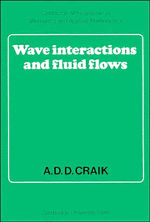Book contents
- Frontmatter
- Contents
- Preface
- 1 Introduction
- 2 Linear wave interactions
- 3 Introduction to nonlinear theory
- 4 Waves and mean flows
- 5 Three-wave resonance
- 6 Evolution of a nonlinear wave-train
- 7 Cubic three- and four-wave interactions
- 8 Strong interactions, local instabilities and turbulence: a postscript
- References
- Index
8 - Strong interactions, local instabilities and turbulence: a postscript
Published online by Cambridge University Press: 01 June 2011
- Frontmatter
- Contents
- Preface
- 1 Introduction
- 2 Linear wave interactions
- 3 Introduction to nonlinear theory
- 4 Waves and mean flows
- 5 Three-wave resonance
- 6 Evolution of a nonlinear wave-train
- 7 Cubic three- and four-wave interactions
- 8 Strong interactions, local instabilities and turbulence: a postscript
- References
- Index
Summary
Strong interactions, local instabilities and turbulence: a postscript
Short waves and long waves
Small-wavelength disturbances may ride on large-amplitude long gravity waves. The orbital velocities of fluid particles due to the long waves provide a variable surface current through which the short waves propagate. When this current is comparable with the propagation velocity of the short waves relative to the long ones, their interaction is no longer weak. Nevertheless, the characteristics of the short waves may still be described, at least in part, by Whitham's theory of slowly-varying wave-trains in an inhomogeneous medium (see §11.3). Phillips (1981b) deduced from wave action conservation that capillary waves are likely to be ‘blocked’ by steep gravity waves. In much the same way, Gargett & Hughes (1972) earlier showed that short gravity waves may be trapped by long internal waves, so leading to caustic formation and local wave breaking. Untrapped modes also undergo amplitude modulations by the straining of the dominant wave field.
Computations of Longuet-Higgins (1978a, b) and McLean et al. (1981), already described in §22.2, display generation of short waves by high-order instability of steep gravity waves. In addition, finite-amplitude wave-trains necessarily contain bound harmonics, which travel with the fundamental Fourier component. Weakly-nonlinear interaction of neighbouring frequency components may also give rise to phase-locking of modes.
For these reasons, and doubtless others besides, measurements of the phase speeds of Fourier components of wave fields often reveal significant departures from the linear dispersion relation, even after allowance is made for wave-induced mean currents.
- Type
- Chapter
- Information
- Wave Interactions and Fluid Flows , pp. 282 - 288Publisher: Cambridge University PressPrint publication year: 1986



